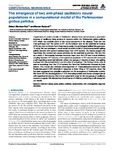The emergence of two anti-phase oscillatory neural populations in a computational model of the Parkinsonian globus pallidus
| dc.contributor.author | Merrison-Hort, R | |
| dc.contributor.author | Borisyuk, R | |
| dc.date.accessioned | 2017-05-10T15:47:04Z | |
| dc.date.available | 2017-05-10T15:47:04Z | |
| dc.date.issued | 2013 | |
| dc.identifier.issn | 1662-5188 | |
| dc.identifier.issn | 1662-5188 | |
| dc.identifier.other | ARTN 173 | |
| dc.identifier.uri | http://hdl.handle.net/10026.1/9220 | |
| dc.description.abstract |
Experiments in rodent models of Parkinson's disease have demonstrated a prominent increase of oscillatory firing patterns in neurons within the Parkinsonian globus pallidus (GP) which may underlie some of the motor symptoms of the disease. There are two main pathways from the cortex to GP: via the striatum and via the subthalamic nucleus (STN), but it is not known how these inputs sculpt the pathological pallidal firing patterns. To study this we developed a novel neural network model of conductance-based spiking pallidal neurons with cortex-modulated input from STN neurons. Our results support the hypothesis that entrainment occurs primarily via the subthalamic pathway. We find that as a result of the interplay between excitatory input from the STN and mutual inhibitory coupling between GP neurons, a homogeneous population of GP neurons demonstrates a self-organizing dynamical behavior where two groups of neurons emerge: one spiking in-phase with the cortical rhythm and the other in anti-phase. This finding mirrors what is seen in recordings from the GP of rodents that have had Parkinsonism induced via brain lesions. Our model also includes downregulation of Hyperpolarization-activated Cyclic Nucleotide-gated (HCN) channels in response to burst firing of GP neurons, since this has been suggested as a possible mechanism for the emergence of Parkinsonian activity. We found that the downregulation of HCN channels provides even better correspondence with experimental data but that it is not essential in order for the two groups of oscillatory neurons to appear. We discuss how the influence of inhibitory striatal input will strengthen our results. | |
| dc.format.extent | 173- | |
| dc.format.medium | Electronic-eCollection | |
| dc.language | eng | |
| dc.language.iso | eng | |
| dc.publisher | Frontiers Media SA | |
| dc.subject | Perkinson's disease | |
| dc.subject | globus pallidus | |
| dc.subject | oscillation | |
| dc.subject | synchronization | |
| dc.subject | HCN | |
| dc.subject | downregulation | |
| dc.subject | deep-brain stimulation | |
| dc.title | The emergence of two anti-phase oscillatory neural populations in a computational model of the Parkinsonian globus pallidus | |
| dc.type | journal-article | |
| dc.type | Article | |
| plymouth.author-url | https://www.ncbi.nlm.nih.gov/pubmed/24348374 | |
| plymouth.issue | DEC | |
| plymouth.volume | 7 | |
| plymouth.publication-status | Published online | |
| plymouth.journal | Frontiers in Computational Neuroscience | |
| dc.identifier.doi | 10.3389/fncom.2013.00173 | |
| plymouth.organisational-group | /Plymouth | |
| plymouth.organisational-group | /Plymouth/Faculty of Science and Engineering | |
| plymouth.organisational-group | /Plymouth/REF 2021 Researchers by UoA | |
| plymouth.organisational-group | /Plymouth/REF 2021 Researchers by UoA/UoA11 Computer Science and Informatics | |
| plymouth.organisational-group | /Plymouth/Users by role | |
| plymouth.organisational-group | /Plymouth/Users by role/Researchers in ResearchFish submission | |
| dc.publisher.place | Switzerland | |
| dcterms.dateAccepted | 2013-11-12 | |
| dc.identifier.eissn | 1662-5188 | |
| dc.rights.embargoperiod | Not known | |
| rioxxterms.funder | Biotechnology and Biological Sciences Research Council | |
| rioxxterms.identifier.project | A neuronal network generating flexible locomotor behaviour in a simple vertebrate: studies on function and embryonic self-assembly | |
| rioxxterms.versionofrecord | 10.3389/fncom.2013.00173 | |
| rioxxterms.licenseref.uri | http://www.rioxx.net/licenses/all-rights-reserved | |
| rioxxterms.licenseref.startdate | 2013 | |
| rioxxterms.type | Journal Article/Review | |
| plymouth.funder | A neuronal network generating flexible locomotor behaviour in a simple vertebrate: studies on function and embryonic self-assembly::Biotechnology and Biological Sciences Research Council | |
| plymouth.funder | A neuronal network generating flexible locomotor behaviour in a simple vertebrate: studies on function and embryonic self-assembly::Biotechnology and Biological Sciences Research Council |


